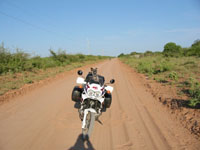Roadinfo Bolivia:
You come from Peru:
The faster way is over Desaguadero. To La Paz 1,5 hours.
If you want to visit the Lago go over Copacaba, which means you have to use a ferry later on (10 Bolivianos for a bike). The way could be snowy over ten km+ when cold. To LP 4 hours.
Both ways are pure asfalt.
You come from Chile:
Best way to hop over the Andes is Tambo Quemado from Arica coming. A totally paved road but it is always terribly cold there. Some parts of road have faults on Chile side especially after rain. Arica - La Paz 7 hours
You come from Argentina:
In San Salvador de Jujuy you have to make up your mind, where to cross.
Bordertowns: Professor S. Mazza - Yacuiba
It is warm here (Chaco). The road is perfect to a town called Camiri. Then a sandy part starts, which is more or less 150 km to a town called Abapo (there is a lot of constructing now, which means some terribly sandy parts). The the road is paved again to Santa Cruz. From there all the way is paved with two short exceptions in the Chapare region. Yacuiba - LP = 1315km (2 days+).
Bordertowns: La Quiaca - Villazon
Colder here (Highlands), way goes over Potosi (very cold). Way was terrible, but now the most terrible parts are paved. We made in Sep. 2003 the border to Argentina (over Tarija) to La Paz (over Potosi and Oruro) in only 19 hours drive. The roads are a lot better now.
There is also a train from Villazon to Oruro. The luxury class costs a person 21$US, a bike 80$US (one cubicmetre is 40$US). The train is excellent (our bikes arrived in Oruro safe and sound - so did we). You have to give them your bike the day of leaving in the morning, leaving time is 3p.m.. You may enter only on weekdays (Sunday is no train, Saturday means arriving on Sunday means they do not open the wagon in Oruro means no bike for you).
From Oruro (arriving time around 7 a.m.) it is 240km to La Paz on a paved road with holes here and there (be careful busses come over).
You come from Brasil:
This way I only know by using the "death-train" from Santa Cruz to Puerto Suarez (in Brasil: Corumba). It is a simple sandy road and the Bolivian map says "not to be used in rain". There are some little villages along the track, but I have no clue, what they can provide. The trip in the train was one of our adventure highlights here. I would not recomend it. To bring the bikes on board was a tricky thing in SC and we had to pay 50$US for each bike (we booked in advance). But in the last moment they tried to receive more. In addition I had to pay some money to the workers, who suggested me something like "pay us or expect a damaged bike in Puerto Suarez".
My advice:
1. The dirt way from Villazon over Potosi to LP:
You are an experienced rider, you know how to fix a flat tyre yourself with freezing fingers and there is a good hope of no rain. The road is now (as mentioned above) a lot better, but sometimes lonesome. For people who want to see a bit, thats the way to go.
I had my hardest time on this muddy road, but now the worst parts are paved and the gravel parts were okay.
2. The way with sandy part from Yacuiba over SC to LP:
You can handle your bike in sand and mud and don't mind a little water crossing. You don't have heavy rain.
3. The train from Villazon to Oruro:
You could do with a break, driving thru the night in a fine train. You don't want to break anything on your bike and aventures are for the crazies or you just don't have time.
4. Crossing the Andes to San Pedro de Atacama in Chile:
You have time and some warm clothes? Okay. The only bad thing is the 150(?)km up and downs (waves on the way) on Argentina side. Chile has perfect paved ways only.
Info: I know all of these posibilities and made them on my Africa Twin with street tyres.
